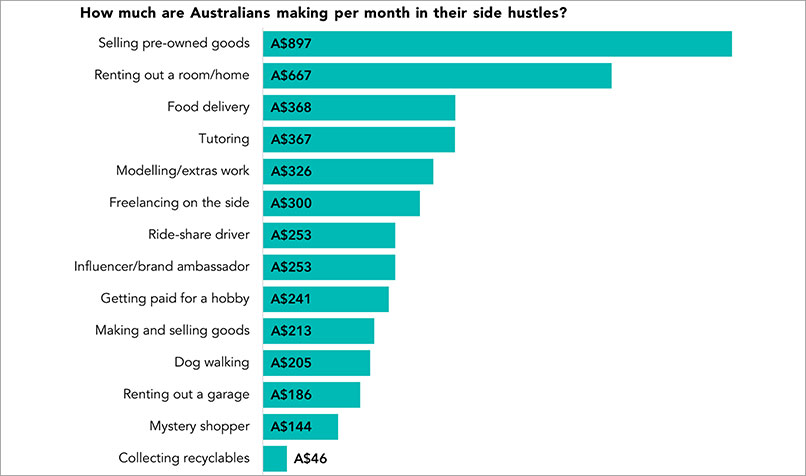Loading component...
At a glance
Technological advances and flexible work have opened the door for many people to set up a lucrative side hustle while working a full-time job. While a creative or entrepreneurial for some, for others, a side hustle is born out of a need to make ends meet.
Side hustle ideas to make money
While a side hustle is sometimes considered to be any second, part-time job, the term typically refers to earning income from work that is creative, monetises a hobby or involves creating a small business.
Side hustles can also be a way to earn passive income.
Examples of popular side hustles include:
- selling pre-owned goods, especially on platforms like Facebook Marketplace
- real estate, from renting out a room or house on Airbnb to purchasing property to renovate and flip
- becoming a social media influencer or content creator, including teaming up with brands for affiliate marketing
- getting paid for a hobby, such as by playing video games on streaming services like Twitch
- designing print-on demand (POD) products such as t-shirts or posters and selling them on an online store, such as RedBubble
- creating handmade products to sell on platforms such as Etsy.
According to October 2023 data from Finder, the most lucrative side hustle for Australians is selling pre-owned goods, where they make an average of A$897 per month, followed by renting out real estate, at an average of A$667 per month. Ride-share driving earns an average of A$253 per month – the same as social media influencing.
Resources exist to help prospective entrepreneurs with their side hustles. For instance, Workforce Australia’s Self-Employment Assistance program can help Australians to turn their business idea or an existing small business into a viable business.

Ecommerce platform Shopify’s list of the top 30 side hustle ideas for 2024 puts monetising a YouTube channel in first place – followed by selling digital products, tutoring (online or in person), package delivery and starting a podcast.
Growing popularity of side hustles
Side hustles and second jobs are becoming increasingly popular against the backdrop of the cost-of-living crisis. This trend is often heightened among Generation Z.
Australian Bureau of Statistics (ABS) data from March 2024 shows that 974,000 Australians, or 6.7 per cent of all employed people, have opted to find another source of income through multiple jobs, compared with 13.4 million single job-holders.
Research from GoDaddy Australia reveals that more than 60 per cent of Gen Z see a side hustle as more attractive than earning extra income through traditional roles like hospitality and retail.
"Employers typically have two concerns about side hustles. One is a conflict of interest and the protection of intellectual property and the other is overload. Are they working too many hours, and will it affect their full-time job?"
MarketWatch reports that while more than half of Americans have adopted side hustles, for Gen Zs, it is 71 per cent.
In the UK, 43 per cent of Brits have a side hustle in 2024, with the average side hustle earning income at £207 (A$398) per week, or £900 (A$1728) per month, according to research from Finder.
Deloitte’s 2023 Gen Z and Millennial Survey reveals that 34 per cent of Singaporean Gen Zs have taken on a side hustle, a marked increase from 17 per cent in 2022.
In India, 66 per cent of Gen Z workers opt to pursue a second job, according to 2023 research from HR Katha.
Legal and ethical considerations for employers
Before jumping into a new side hustle, it is important to consider all the factors, particularly how it can affect a full-time job that is the primary source of income.
An employee’s side hustle can present valid legal and ethical concerns for employers.
“Employers typically have two concerns about side hustles,” says workplace expert Michelle Gibbings.
“One is a conflict of interest and the protection of intellectual property and the other is overload. Are they working too many hours, and will it affect their full-time job?”
If an employee says they are setting up a side business, the best approach is to be clear about the boundaries, Gibbings says.
“There are occasions where people want to keep their full-time job while they’re testing the waters to see whether their side hustle is actually a viable proposition. If it is in the same professional area, there needs to be a very clear distinction that has no connection with the day job,” she says.
For people who are pursuing a passion, such as an accountant with a photography business on the side, a supportive approach may benefit the business, Gibbings says.
"People can run into issues if they are performing work on another business during time that they are paid to be performing work for an employer. It can give rise to a valid basis for disciplinary action to be taken."
“It can help the organisation if the employee is developing a skill set that the employer can leverage in some way. By being supportive and flexible, the person sees the company as a great place to stay.”
According to Patrick Turner, principal in employment law at Maurice Blackburn, “People can run into issues if they are performing work on another business during time that they are paid to be performing work for an employer.”
“It can give rise to a valid basis for disciplinary action to be taken,” Turner adds.
Some industries, including those in professional services, may even seek to prohibit what an employee can do outside work hours if it relates to the type of work being performed.
“We often see disputes arising where there’s some contention that there was a breach of the employment contract by commencing that business during the course of the employment,” Turner says.
No two cases will be the same, Turner adds. The critical step is for anyone looking to start a side hustle who is concerned their employer may take issue with is to get advice.
“If someone is passionate about a side project that they may derive a reasonable income from, it is worth paying to get professional advice prior to going down a certain path and then getting pulled up by an employer who has taken an aggressive stance at the last minute,” Turner says.

